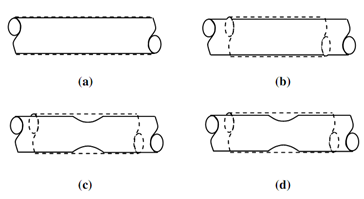Measure of Ductility
This has been stated earlier such a ductile material exhibits taken as deformation in the plastic zone. Of course, this deformation or strain can be employed as a measure of ductility. After that the total deformation suffered via a specimen or test piece upto fracture divided via the original length or among the gauge points multiplied via 100 is called as percent elongation. Percent elongation is considered as in index to describe the material's ductility. This would mean that higher the percentage deformation, further ductile is the material. Conversely, percent elongation will depend on what gauge length is selected. To know such sequence of deformation as illustrated in following Figure along with reference to diagram of Figure of with Strain Scale Expanded Showing Yield Deformation and Shortened to Show Ultimate and Fracture Point just with Yield Point will have to be known well. During elastic deformation the strain is extremely uniformly and small distributed over entire length of the specimen or test piece. Hardly any change in diameter or length can be visually seemed. Even further the yield point or elastic limit that changes are minute, however just before eventual point the plastic deformation starts to localize in a minute part of length and reduction in diameter or in the maximum change in length happens in this area. Eventually fracture happens in the necked area.

Figure: Sequence of Deformation of a Cylindrical Specimen with Reference to Figure of with Strain Scale Expanded Showing Yield Deformation and Shortened to Show Ultimate and Fracture Point (a) Just Before Point, a, (b) Just Before Point, f, (c) Just After Point, f and (d) At Point g
Following figure shows how the plastic deformation is dispersed along the length of the test piece or specimen. Various gauge points have been represented marked on the test piece or specimen. This can be seen that via choosing any type of pair of gauge points, equidistant from the centre, one might arrive at a value of percent elongation that will differ from such acquired by choosing a various pair of gauge points. This illustration shows such percent elongation is not a unique quantity for a material, except may vary along with gauge length. For this purpose gauge length is standardized hence comparison of ductility among two materials may be created consistently. For cylindrical specimen or test piece gauge length of five times the diameter is chosen as a standard. Although in any situation percent elongation is explained along with gauge length on such this has been calculated.

Figure: Distribution of Elongation the Length of Tension Specimen
The value of percent elongations can be acquired from demonstrated as the strain at the instant of fracture multiplied throughout 100. Almost, the two pieces of specimen or test piece after fracture might be placed together touching at fracture surface and the displacement among gauge points noted to measure last length Lf. After that,
% elongation = ((Lf - Lo) Lo) × 100 ......................Eq(5)
The percent reduction in region of cross-section is also employed as a measure of ductility. This is explained as given:
% reduction in area =(( Ao - Af )/Ao)× 100...............Eq(6)
Here L and A represent the region of length and cross-section respectively, o and f are respectively the suffixes to indicate original and final values.
This may be known by above description that both % reduction and % elongation in area would explain the local ductility of the material. Maximum consistent or uniform strain that is the strain immediately before necking begins or the strain consequent to eventual stress might sometimes be employed to indicate the ductility of a material.
Ductility is a significant property of material that governs its capability to be deformed in a process like drawing, extrusion and forging. Adequate ductility ensures about the materials during these procedures will not fracture. All linked property by virtue of that sheets can be rolled from material is known as "malleability".